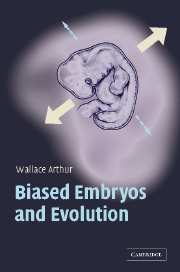Book contents
- Frontmatter
- Contents
- Preface
- Acknowledgements
- 1 The microscopic horse
- 2 What steers evolution?
- 3 Darwin: pluralism with a single core
- 4 How to build a body
- 5 A brief history of the last billion years
- 6 Preamble to the quiet revolution
- 7 The return of the organism
- 8 Possible creatures
- 9 The beginnings of bias
- 10 A deceptively simple question
- 11 Development's twin arrows
- 12 Action and reaction
- 13 Evolvability: organisms in bits
- 14 Back to the trees
- 15 Stripes and spots
- 16 Towards ‘the inclusive synthesis’
- 17 Social creatures
- Glossary
- References
- Index
4 - How to build a body
Published online by Cambridge University Press: 02 December 2009
- Frontmatter
- Contents
- Preface
- Acknowledgements
- 1 The microscopic horse
- 2 What steers evolution?
- 3 Darwin: pluralism with a single core
- 4 How to build a body
- 5 A brief history of the last billion years
- 6 Preamble to the quiet revolution
- 7 The return of the organism
- 8 Possible creatures
- 9 The beginnings of bias
- 10 A deceptively simple question
- 11 Development's twin arrows
- 12 Action and reaction
- 13 Evolvability: organisms in bits
- 14 Back to the trees
- 15 Stripes and spots
- 16 Towards ‘the inclusive synthesis’
- 17 Social creatures
- Glossary
- References
- Index
Summary
Ease of study has been one of the main criteria that have guided developmental biologists in their choice of creatures. If we are interested in understanding the general principles of how organisms develop, we can in theory choose any creature we please. There is, however, the caveat that we may end up unwittingly choosing one that has peculiarities of development that render attempts to use it as a basis for generalizations misleading or just downright wrong. But this is a risk worth taking. Research by its very nature is always probing in the dark, and the risk of probing in what later turns out to be the wrong direction is always with us. If we don't take this risk, we never venture out into any sector of the darkness of our ignorance, and we never learn anything.
So, most research in developmental biology is based on what have become known as model systems, in other words a small select bunch of species that are particularly amenable to study, and that can, with luck, be used as ‘models’ of how development works generally. The main model systems that have been, and are being, used in this way are the mouse, the chick, the frog, the zebrafish, the fruitfly, the roundworm and, on the plant side of the great divide, a little weed called thale cress (Figure 5). We know much more about the development of these seven creatures than any others. And of course this model system approach is self-reinforcing.
- Type
- Chapter
- Information
- Biased Embryos and Evolution , pp. 39 - 52Publisher: Cambridge University PressPrint publication year: 2004



